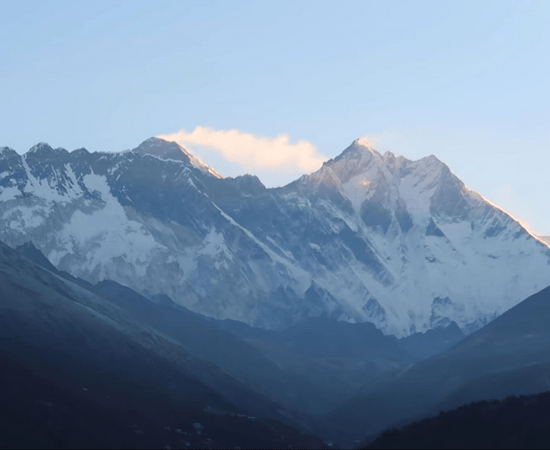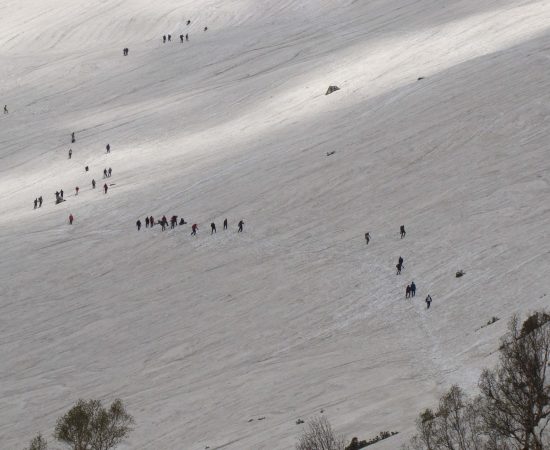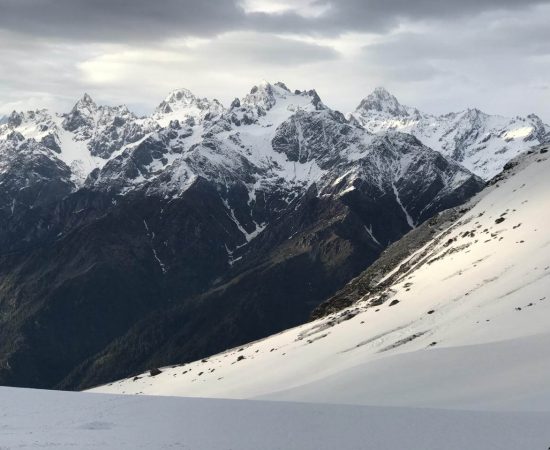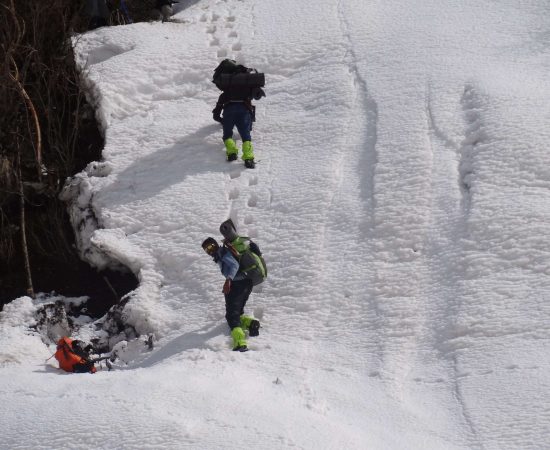BURAN GHATI PASS TREK
Shimla, Himachal Pradesh
Rated 4.9/5.0 on TripAdvisor. 550 Reviews


Key Highlights
- Altitude : 4575 mts
- Time : 7 Days - 6 Nights
- Region: Shimla
- Best Time: May, June, September, October
- Distance: 40kms
Overview
BURAN GHATI PASS TREK
The Buran Ghati Pass Trek is regarded as one of the Himalayas' most comprehensive hikes. The journey on foot begins in Rohru, about 150 kilometres from Shimla, in the sleepy small settlement of Janglik. As you get to see the colourful landscapes and flora-fuana of the area, this escapade is regarded as being comprehensive in all respects. Because the Pabbar river runs entirely through the valley, it is known as Pabbar valley. You stroll beside the traditional Himachali homes with their distinctive architecture as you begin your climb towards Buran Ghati pass from Janglik, giving you a taste of their culture. But as you leave the settlement, the scenery transforms from pine and oak woods, then into expansive meadows, sparkling streams, and ultimately into the desolate area immediately before the pass. Buran Ghati Pass trek offers you landscapes that have been carefully chosen to satisfy your spirit and pleasure your heart, making it a full and ideal trek for trekking fans seeking genuine beauty as well as the difficulty of crossing the pass. As we make a little diversion on the day of our acclimatisation, the holy Chandranahan Lake is an additional draw for our journey to cross the pass. You face a good challenge on the day of the summit as you ascend up rugged, icy terrain, and are dropped from an almost vertical ice cliff, and then descend snowy slides on the opposite side of the pass. As we descend to the Burua roadhead, you will see that it is surrounded by several fruit trees, including apple, apricot, peach, and pears. This journey is an unforgettable experience full of excitement and enjoyment.
Cost Per Person
Key Highlights
- Altitude : 4575 mts
- Time : 7 Days - 6 Nights
- Region: Shimla
- Best Time: May, June, September, October
- Distance: 40kms
Complete
➽ Itinerary of Trek
Our trip to Janglik will start at Shimla ISBT, where our cars will leave at 8 a.m. precisely. Please be there at 7:30 a.m. early to avoid being late. Since the journey is lengthy and takes around 6 hours to complete, it is crucial to get started as early as possible to avoid traffic or road blockages. We shall go via Kufri's picturesque lanes. We'll even stop for lunch somewhere in the middle, then continue on our way to Rohru. As you approach Rohru, the forest transforms, revealing a wide area covered with apple orchards. Awe-inspiring Himachali architecture greets us as we approach Janglik, a tranquil town nestled in the foothills of the Himalayas. Here, your trek guide will give you a briefing on the route, and you'll spend the night in one of Janglik's lovely homestays.
Today is the first day of our journey. Therefore, warm up your body and stretch your muscles before eating a nice breakfast at our Janglik homestay. After that, pick up our packed lunch, which we'll have throughout the trip, and set out into the path. We will get a fair sense of everyday life in these isolated villages of Himachal Pradesh at the start of the walk. More residences with stunning architecture and animals roaming freely around the town will be visible to us. We will leave the settlement in about 30 minutes; from here, the route becomes steep and we rise into the pine and oak trees, which are sheltered. We ascend steeply through the forest, but the air is filled with the lovely aroma of the trees, which keeps us feeling fresh. At some places, the forest will part, allowing you a clear view of the Pabbar River running through the valley's centre and the snow-capped mountains on the valley's opposite side. We comfortably navigate the final incline on the route before leaving the forest and arriving at Dyara Thach. With the enormous expanse of the meadow surrounded by woodland and snow-capped mountain peaks, the view is really breathtaking. After tea and snacks in the evening, take some time to take a leisurely walk over this lovely meadow.
Get up early to capture that stunning dawn that will cast a golden glow over the valley. The vista of the valley will capture your eyes entirely. After that, we'll do some morning exercises to get the day going on an energetic note. After breakfast, we'll set off on our hike to Litham, where we'll spend the night. Although the distance we must go today is little, we won't have much time to do it since we will be gaining height as we leave the treeline and ascend to a higher altitude where trees cannot grow. Today's course has a few mild incline climbs but is mostly severe. When it comes to providing the greatest vistas and going through glittering streams, the Buran Ghati hike never lets you down. To ultimately get to our camping ground in Litham, where we will be welcomed with a cooked supper, we will travel via mountain spurs. Enjoy the magnificent views in and around Litham while getting some exercise to help your body adjust to the high altitude.
We want to visit the holy Chandranahan Lake on this day so that we may take a diversion and gain some elevation, which will aid in acclimatisation. We will grab our day packs and go for our climb to Chandranahan Lake after breakfast. Today's hike is primarily uphill as we ascend the mountain. We will begin to see the waterfalls after an hour of climbing. These waterfalls have their source from the glacier that is situated above of Chandranahan Lake. The landscape turns into a stony scree type after winding along goat tracks. This suggests that we are getting nearer to the lake. The lake's surroundings are quite stunning. Even better, you may circle the lake in a clockwise direction and make a little prayer to Lord Shiva, who is the source of the lake's name. The same path that we used to ascend to Chandranahan Lake will be followed. This will help you become respectable. After arriving at the campground, we'll have lunch and spend the rest of the day relaxing and having fun in Litham.
To reach Dhunda, the base camp for the Buran Ghati pass, we must hike. In order to go to our next campground, we select the best path feasible by travelling through the Pabbar Valley's north-eastern edge. Even though the path is brief, it does not fall short of our expectations for beauty. Alongside the Pabbar River, we will pass a few tiny lakes. The toughest obstacle of the day is still ahead of us as we must cross the river while dipping our feet into the chilly water and working as a team. The last section of the route today is steep, and to get to Dhunda, where we will pitch up camp, we zigzag on the spur. The micro spikes and gaiters you need to traverse the pass the next morning will be provided to you. Due to the fact that the summit attempt begins before daylight, we will have lunch and supper early.
Finally, the day of reckoning has come; this is the day we cross the Buran Ghati pass. We get up as early as three in the morning and get ready for the climb ahead. We will have a brief breakfast before heading to the pass so that we will have energy for the climb. We will also bring our packed lunch. We will need head torches to illuminate our path and many layers of clothes to keep us warm because our walk will start before daylight. The snow will be firm and crisp, making it simpler to walk on, making this the ideal time to traverse the mountain. From Dhunda, we will ascend the ridge, navigating boulders and loose rock along the route. It is considerably simpler to climb on the snow during the post-monsoon season. It takes an hour to go from the pass's base to its summit. Take in the vista after you've gotten to the summit. It is advised that hikers use a rope to lower themselves down after crossing the pass since the opposite side has an almost vertical snowy cliff. Thereafter, there are several slides that enable us to go far in a short amount of time. Obtain the campground in Munirang by late afternoon. Celebrate the pass's successful completion with your team mates and then get some much-needed rest.
We have breakfast before heading to Barua as the expedition comes to a close. We go past apple orchards, and if you do this walk in September or October, locals will even sell you apples that you may purchase and bring back to your own country. Please respect the people and ask for permission before picking the apples. The vans that will transport you to Shimla are ready when we finally arrive at Barua, close to the Karcham Dam. We bid the local workers farewell while carrying wonderful memories in our hearts. We then go on to Shimla.
Enquiry For Group Bookings
Guidelines
➽ Preparation for Trek
As you well know, the great Himalayan trek is one that requires careful preparation, a strategy that allows for enough flexibility to adapt to whatever challenges may arise.
Therefore, here are some things to consider before setting out on your trek:
⦿ Physically – You should start working out at least a month before signing up for a program if you want to be physically prepared for the rigours of a journey. Strengthen your legs by jogging and working out regularly to increase your stamina. To better acclimatise to the environment and increase your resilience on the walk, you should give up smoking and undertake breathing exercises twice a day. Engage in vigorous physical activity, such as playing sports, doing Yoga, or running.
⦿ Mentally –
Getting in shape physically is essential, but mental preparation is just as crucial for a successful walk. Take time to enjoy your regular activities, maintain a healthy diet and sleep schedule, and unwind before embarking on a hike. Predictions regarding the journey should not cause mental worry. Spend time with your closest pals to recharge your batteries and renew your spirit. Pre-trek preconceptions are unwarranted since the first contact with the other trekkers is certain to be a source of inspiration and energy. Conditions during the walk will contribute to the increase in mental readiness. The mental repercussions of physical disadvantages will not be ignored. So, when you hike, pay attention to different regions of your body and purposefully relax them. If you want to enjoy your hike, you should learn to loosen up a little, particularly in the hips. Think about your descent as a simple dance, and enjoy the natural rhythms that the path and your body can discover together gradually, whether you're on a flowing downhill route or a frightening slope. Try out a few new walking techniques to add some fun to your commute without worrying about getting somewhere in particular. Maintaining mental fitness mostly requires a willingness to relax and take in the journey, rather than subjecting oneself to undue stress.
⦿ Technically-
Get the right size hiking boots and go for it, from a technical standpoint. You should make use of 60 litres. To become acclimated to carrying heavy items, it is recommended to utilise a backpack on a regular basis. Get a hiking stick, a water bottle, some thermal socks, a fleece or feather coat, some long pants, a poncho, some flip-flops, and any devices you may need like a camera or a power bank (DSLR or digital camera).
Guidelines
➽ Things to Carry
- Good Trekking Boots: You need sturdy trekking boots with supportive high ankles. Don't bring your running shoes. U can carry extra floaters/flip flops also.
- Wear warm clothing, such three-layer coats, fleece upper, hollow fill or down-filled jackets. Carry full-sleeved T-shirt. Carry cotton hiking trek pants and warm pant for your lower body. Never bring shorts or jeans on a hike.
- Take top and bottom thermals with you.
- Quick dry towel with light weight and Personal toiletries. Suns cream lotion, sanitizer, tooth brush ad toothpaste, lip balm and antibacterial powder.
- Socks: Bring two pairs of regular socks and two pair of wool socks for wearing at night.
- A head torch is required.
- Sunglasses/ Goggle: UV-protected sunglasses are necessary to protect against sunlight and Snow Mountain.
- There should also be a woolen cap / balaclava, cap, neck gaiter cum face mask and warm fleece and waterproof summit gloves since it will be chilly. Keep waterproof gloves on hand since they become wet in the snow.
- Everyone taking part in the activity should have their own lunchbox, spoon, mug and water bottle/ hydration pack of 2 ltr.
- Raincoats/ponchos: Since snowfall and rain are frequent at high elevations, it is important to have one on hand so as to avoid getting wet.
- Trekking bag of 75 ltr with rain cover.
- Walking stik.
- Electronics: camera (optional) USB cable/USB solar charger, charger/earphones, Power bank fully charged.
- Personal first aid box. Emergency ration, energy bars, dry fruit, electoral/Ors
- Required Documents:
a) Registration Form
b) Medical Certificate (signed by a licensed MBBS physician)
c) NOC form (completed by the trekker)
d) 2 passport-size photos
e) ID Proof photo (not PAN)
g) Insurance upto 5 lac..
Guidelines
➽ How to Reach
Road distance:
Via Road. Shimla and Rampur provide frequent cab services as well as daily bus service to Kinnaur. Shimla and Delhi are linked nicely. You may travel from Delhi to Shimla in 8 to 10 hours via overnight bus (approx 435 KMS). Online ticket reservations are available at www.redbus.in and www.hrtc.gov.in Tip: Given the distance between Delhi and Shimla, the majority of Volvo private buses depart Delhi between 5 and 8 p.m. At 8.30 p.m., the final government bus departs from ISBT Kashmere Gate. Between Rs. 1,200 and Rs. 1,800 are charged by Volvo buses each sector from Delhi to Shimla and vice versa. Delhi to Shimla: Buses depart from Shimla to Delhi between 4 and 8 p.m., same like the return trip. You should expect to arrive in Delhi any time between six and ten in the morning. Plan your subsequent trips just after midday, leaving ample time for bus delays.
The closest train station is:
Chandigarh (260 miles) and Shimla (257 km) are the closest rail stations (370 kms). There are no direct railroad services to Kinnaur. Direct access to private taxi or bus services is available from the train station.
The closest airport:
As a result, there are no direct flights to Kinnaur, and the nearest airport is in Shimla. Which is accessible from Delhi? The airport serving Shimla is located at Jubbarhatti, 23 kilometres from the city, and is linked to Chandigarh and Kullu.
➽ Trip Cost Includes
- Conveyance within the journey.
- Tents that can be shared.
- Advanced and knowledgeable himalayan adventure trips guide.
- Cooks, helpers, and other necessary personnel.
- Vegetarian meals (breakfast, lunch, and dinner) along the journey
- Every organisational prerequisite for a journey
- First aid kit with portal oxygen.
- Camping fees and forest permits.
- All permissions for hiking.
- All meals will be supplied while on the hike. Freshly cooked meals will include a mix of indian, chinese, and continental cuisines.
- Lodging at a hotel, guest house, home, or in tents.
- All of the group's trekking equipment (tents at base camp, use of base camp facilities)
- All trip workers, including porters and mules for everyday items (such as food, tents, and utensils)
➽ Trip cost Excludes
- Airfare or other forms of transportation costs.
- Meals and hotel accommodations.
- Personal costs include washing, cell charging, and lodge showers
- Entry permits or permission for the inner line for foreign participants.
- Personal apparel and hiking supplies, such as liners for sleeping bags and walking sticks, are required.
- Any expenditures associated with rescue efforts or an early expedition departure.
- Guides and sherpa crew are tipped.
- Personal porters to carry hikers' packs
- Personal liability insurance or emergency evacuation costs
- Personal purchases (such as bottles of mineral water, bottled or canned drinks, chocolate, dried fruit, presents, etc.).
- From and to the trailhead, food.
- 5% goods and service tax (gst).
Guidelines
➽ Special Casual Leaves
Government employee can avail the benefit of special casual leave when u join us for a trekking expedition. As per the rule of the pay commission, special casual leave can be availed for up to 30 days in a calendar years for trekking and mountaineering expeditions through a register organization. Himalayan adventure trips are a register adventure tour operator register with Indian mountaineering foundation and Himachal Pradesh tourism. Candidates have to apply for leave at least 30 days before the trek/expedition start.
Testimonials
➽ Provided By The Customers
Everything about our visit to Prashar lake was better than we could have imagined. From our initial contact with Himalayan Adventure Trips, we felt their genuine interest in learning about our group's goals and expectations, and our travels with them reinforced at every turn that they not only understood our requirements but also have the acute skill and expertise to achieve them. Having already had such a wonderful experience with this firm, I will be promoting a trek to Prashar lake to all my friends who share my passion for hiking and will specifically recommend that they work with this outfit. Absolutely fantastic; I have nothing but praise for it.
How useful was this post?
Click on a star to rate it!
Average rating 5 / 5. Vote count: 2
No votes so far! Be the first to rate this post.







